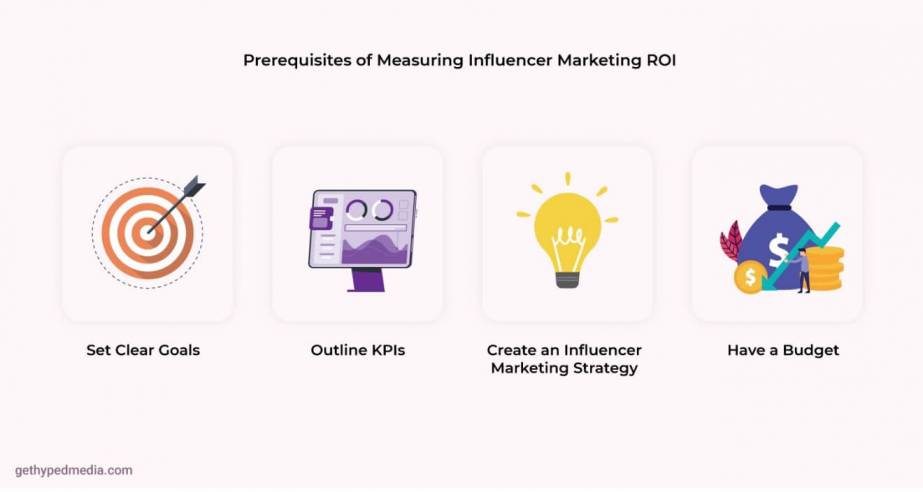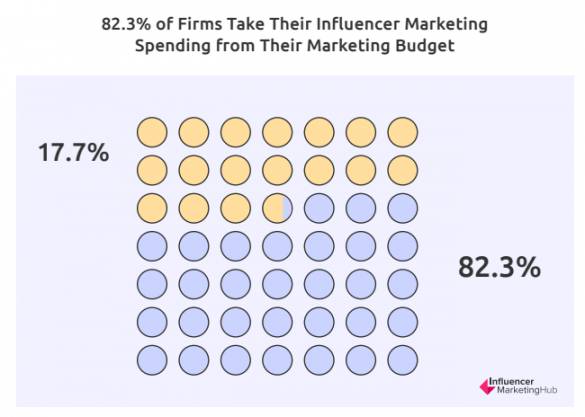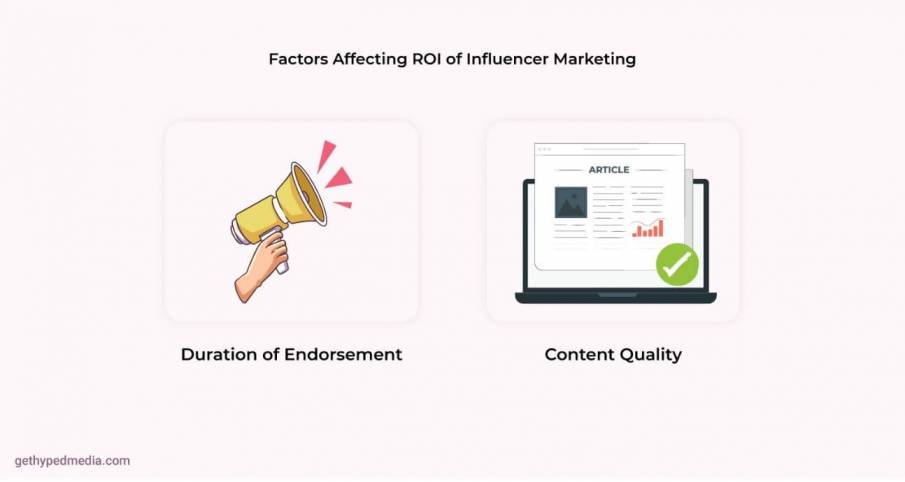Did you know the global influencer marketing platform market was valued at $25.44 billion in 2024 and is expected to grow at an impressive rate of 23.3% per year from 2025 to 2030?

Image via Influencer Marketing Hub
This rapid growth is powered by smart technologies like AI and Machine Learning. These tools help brands discover the best influencers, predict how well their campaigns will perform, and get better results for every dollar spent.
It’s clear that influencer marketing is becoming an even more essential strategy for businesses worldwide.
Table of Contents
What is Influencer Marketing ROI?
Influencer marketing ROI is the ratio of money gained or lost from an influencer marketing campaign relative to the amount invested in it.
Ideally, every marketer’s goal for contracting an influencer is to maximize the return on investment from the campaign. So, having a well-thought-out plan and process is essential.
By learning how to measure influencer marketing ROI, you can determine how well a campaign performed and whether the audience exposed to an influencer’s content acted in some way that benefited your brand.
It could be anything from buying your products or services to signing up for newsletters, downloading an app, or anything else that contributes to the success of your campaign.
Why is Measuring Influencer Marketing ROI Important?
Knowing how to measure influencer marketing ROI, as mentioned earlier, can help you determine whether your efforts resulted in a financial gain for your business or not. This can also help you understand if your campaign drove better results than traditional advertising methods.
And this data can be an important way of figuring out what you should be spending money on for future marketing campaigns.
It also helps measure how good an investment an influencer is for a company. This data can help you decide which influencers are the best fit for your business and help you avoid spending too much on influencers who bring little to no return.
Additionally, measuring and having reliable ROI numbers helps you make better decisions when it comes to budgeting and planning future campaigns.
With a clear indication of what works in terms of performance and reach, you can make more informed decisions and get the most out of your influencer budget.
Finally, ROI helps you identify how you can optimize your influencer campaigns to drive better results.
So now that you know why measuring ROI is important; let’s look at how to measure it.
How to Measure Influencer Marketing ROI: The Prerequisites
Since all social media platforms use algorithms to operate, any change in a given algorithm can affect the organic reach of an influencer marketing campaign.
These constant algorithm updates and the ever-rising rates charged by influencers mean that it’s more important than ever to understand how to measure the ROI of influencer marketing.
Before we get to how exactly you can measure your ROI, it’s important to consider a few prerequisites.

Set Clear Goals
Before setting out to create an influencer marketing campaign, you’ll need to specifically identify the marketing goals you’re looking to achieve. Are you looking to grow brand awareness, build your online community, collect UGC, generate sales, or all of the above? Setting clear goals and prioritizing them will help you identify the right influencers for your brand.
Without clearly prioritizing your goals, it’s easy to get caught up in the act of trying to have your influencer marketing campaign accomplish everything at once. And if you try to prioritize too many goals in one campaign, it’s unlikely that you’ll make meaningful progress on any of them.
Outline KPIs
Determining the key performance indicators (KPIs) that will measure the campaign’s success is always necessary. Without them, you won’t be able to calculate your influencer marketing ROI. These indicators will vary depending on the goals of the campaign.
If the campaign’s goal is to grow brand awareness, for example, then the metrics of most importance to measure would be factors like reach and impressions.
Create an Influencer Marketing Strategy
Without a clear marketing strategy for your influencer campaign, you won’t get the desired results.
When creating an influencer strategy, you’ll want to consider the best social media channels to reach your target audience, best content formats for your goals, and more. All of these factors can make a big difference in your campaign’s results.
For example, if your brand needs UGC to repurpose for other marketing tactics like your website, you’ll want to focus on partnering with influencers to generate static in-feed content.
But if your brand awareness is already high and you’re looking to maximize conversions, you’ll want to focus on having influencers create high-impact video content that captures the audience’s attention and gets them engaged.
Have a Budget
Every influencer marketing campaign is an investment. Similar to other marketing methods, influencer marketing requires a budget that can include items such as the influencer’s fees, the cost of software for sourcing and analytics during the campaign, and labor for campaign strategy and management.
Ideally, you’ll want to estimate these expenses and assess the total campaign budget that you can afford. The cost of influencer marketing is a crucial step in maximizing the ROI of a particular campaign.
About 82% of organizations take their influencer marketing budget from their total marketing budget. Deciding what portion of your total marketing budget to spend on influencers will depend on the goals for your business and influencers specifically.

Image via Influencer Marketing Hub
Most brands have success with influencer marketing campaign budget planning by first determining the maximum budget they can afford to spend on influencers. Then, with the campaign budget established, they can work backwards by setting KPIs and calculating the estimated campaign results.
Leverage AI and Advanced Tools
AI-powered platforms like Upfluence and CreatorIQ can help optimize every stage of your campaign:
- Influencer Discovery: Find influencers whose audiences match your target demographic.
- Predictive Analysis: Forecast campaign performance and expected ROI.
- Real-Time Tracking: Monitor engagement and conversions to adjust your strategy on the fly.
By following these stages, you create a well-structured campaign that not only measures ROI effectively but also improves your chances of success.
Important KPIs to Track in Influencer Marketing
To measure ROI for influencer marketing, you’ll need to look at both quantitative and qualitative data.
Combining the two provides a broader outlook into the campaign and will give you a comprehensive overall view.
Let’s look at the KPIs you need to keep an eye on to measure the ROI of your influencer marketing campaigns.
Reach and Impressions
What’s the difference between reach vs. impressions?
According to Sprout Social, reach is the total number of people who see your content. Impressions are the number of times your content is displayed, no matter if it was clicked or not.
So, for example, your campaign content may reach 1 million people, and your content may be displayed an average of two times to each of those people. This would result in a campaign reach of 1 million with 2 million total impressions.
It’s common for influencer marketing campaigns to gauge the level of brand awareness by tracking and measuring both reach and impressions.
The more your audience is exposed to your brand and products, the more likely they are to consider your brand for their next purchase.
Engagement Rate
The engagement that the influencer’s content generates on social media is extremely important. The level of an influencer’s engagement is a direct indication of how interested their audience is in their content.
The engagement rate of your influencer partners can make a big difference in helping you get your brand in front of your target audience and growing your reach.
That’s why engagement rate tends to be the single most important metric for influencer marketers.
Engagement can be broken down, depending on the social platform, into engagement rate and number of engagements. The number of engagements can include actions such as likes, comments, saves, and shares.
Make sure to track and measure it all, then compare the performance of your influencers and campaigns to determine what’s working best in your strategy and maximize your ROI.
The average influencer engagement rate on each social platform varies greatly. Consider the average engagement rates below when considering which social platforms to include in your campaign strategy.

Image via Influencer Marketing Hub
After all, posts that get higher engagement are likely to be seen by more people, which will boost the total campaign reach.
Revenue and Conversions
Ultimately, the goal of every brand is to grow its revenue and sales. Brand awareness and consideration comes first though.
But what if your brand already has a high awareness among your target audience? Then it should be a no-brainer that one of the most important KPIs that you’ll want to measure is the revenue generated directly from your influencer marketing campaign.
Be sure to track the conversion rate as well in addition to the number of conversions.
How can you do this?
You can track link clicks generated by influencers by providing each influencer with a UTM link at the start of the campaign. UTM links allow you to track the traffic each influencer generates individually.
With UTM links, it’s easy to measure and analyze the volume of traffic that influencers are driving and also figure out metrics like Cost Per Click (CPC). You can also use tools like Google Analytics to track the actions of the traffic driven to your site by the influencers in your campaign.
Earned Media Value (EMV)
Earned Media Value measures the monetary value of the exposure generated by your influencer campaign. It’s calculated by comparing the campaign’s engagement and impressions to what it would have cost to achieve the same results through paid advertising. EMV is particularly useful for campaigns focused on brand awareness, as it helps quantify the reach and impact of the influencer’s content.
Sentiment Analysis
While numbers are important, understanding the tone of audience reactions is equally valuable. Sentiment analysis evaluates whether the comments and feedback on influencer content are positive, neutral, or negative. Positive sentiment indicates a strong alignment between the influencer, audience, and brand, while negative sentiment may highlight mismatched messaging or campaign goals. Tracking this metric ensures your campaign resonates well with the target audience and maintains your brand’s reputation.
Calculate Influencer Marketing ROI
Once you’ve established the KPIs you need to track and measure, it’s time to calculate the ROI of your influencer marketing campaigns. ROI, or Return on Investment, is the ratio of the profit gained from a campaign to the total cost of running it.
This calculation helps you understand how effective your investment in influencer marketing has been and whether it’s delivering the desired value.
The basic formula for calculating influencer marketing ROI is:
ROI = [(Revenue Generated – Cost of Campaign) / Cost of Campaign] x 100
For example, if your campaign cost $10,000 and generated $20,000 in revenue, your ROI would be 100%. This means you doubled your initial investment, indicating a successful campaign.
The calculation becomes slightly more complex when your campaign focuses on metrics like brand awareness instead of direct revenue.
In such cases, you may need to consider indirect benefits like increased traffic, social media growth, or Earned Media Value (EMV). EMV quantifies the value of the exposure your campaign generated, even if it didn’t immediately translate into sales.
For conversion-driven campaigns, using tools like UTM links is essential. These links allow you to track the traffic and actions generated by each influencer individually.
This provides a clear picture of which influencers contributed the most to your campaign’s success. Additionally, tools like Google Analytics can help monitor on-site behaviors, such as clicks, sign-ups, or purchases, directly tied to the campaign.
While ROI calculations provide valuable insights, it’s important to remember that influencer marketing often has long-term benefits.
Campaigns that focus on brand building, customer engagement, or loyalty may show their true value over time, beyond the immediate results. By combining short-term metrics with ongoing analysis, you can ensure your campaigns continue to deliver meaningful returns.
What’s an Example of a Good Influencer ROI?
After measuring your influencer marketing ROI, you need to check whether it is a good and acceptable figure for your business.
Influencer Marketing Hub’s 2020 report shows that a good ROI for influencer marketing is $5.78 for every dollar spent.

Image via Influencer Marketing Hub
While this is a good figure, it’s important to remember that the type of business, the metrics used, and the industry itself can affect this number.
So, while striving to learn how to measure influencer marketing ROI for your business, always keep these factors in mind and customize your calculations accordingly.
More Things to Keep in Mind
Now that you know all about the various KPIs that go into influencer marketing ROI, let’s take a look at a few other things you’ll want to be aware of.

Rise Above Standard Metrics
While the goal of any marketer is to maximize the campaign KPIs, it’s easy to get lost in the vanity metrics. Engaging an influencer can do way more for your brand’s strategic growth than what’s shown in the numbers.
Other than metrics like engagement and sales, you can measure things like brand sentiment to see if there are shifting perceptions about your brand. If your campaign had an impact on deepening customer relationships, you’ll see evidence of that in the conversations that happen in the comments on influencer’s posts.
Are the influencer’s comments all emojis or one-word responses? Or is the influencer’s comment sections filled with long and elaborate back-and-forth audience conversations around your brand and products? The latter is always the goal, and if your campaign can achieve this level of engagement, you’re bound to see a high ROI.
To achieve positive conversations and change in brand sentiment, you want to only partner with influencers who reflect your brand’s mission and goals.
You May Also Like:
- 10 Best Nutrition Influencers You Can Partner with This Year
- 9 Wine Influencers to Power Up Your Social Media Campaigns</a<>
Calculate Your Earned Media Value
Your influencer marketing ROI calculation isn’t going to be very straightforward all the time. When you’ve got conversions and revenue figures, it’s easy to calculate it.
But what if your goal was to generate brand awareness?
In such a situation, it’s important to calculate your Earned Media Value (EMV) to understand your ROI.
In fact, according to the Influencer Marketing Hub’s 2022 report, 80% of marketers use this metric to measure the success of their influencer marketing campaigns.
EMV helps quantify the total value of media coverage and impressions generated by an influencer campaign.
The only disadvantage of using EMV is how it is measured.
It’s calculated by multiplying the total engagement from the campaign by a CPE (cost per engagement) rate that’s been set by your marketing team or agency.
Sounds complicated? You’re not alone. It is a concept many marketers find challenging to explain to their managers.
Nevertheless, knowing your EMV will provide valuable data on how much total coverage and exposure an influencer has brought to your brand.
This is especially helpful in determining which influencers were most effective at amplifying your message and increasing brand awareness.
The key to getting the most out of your EMV to optimize your campaigns is to continuously track and monitor the data generated from each post in your influencer campaign.
This will help you set realistic CPE goals to accurately measure the campaign’s success.
Request Platform Analytics Reports
You can measure the influencer’s performance metrics only to a certain extent. To get access to all of the data, you’ll need access to the influencer’s platform analytics to fully understand how their content is performing.
You can request that influencers send a copy of their platform analytics to you after they post.
These reports help provide deeper metrics and insights about the campaign and tracking them will help you fully understand campaign performance.
Manually requesting analytics from the influencers in your campaign can get very time-consuming, especially if your campaign includes dozens of influencers.
This is why many brands choose to either purchase access to a 3rd party influencer marketing platform that tracks campaign analytics or hire an experienced influencer marketing agency to track analytics for them.
Other Factors Affecting ROI of Influencer Marketing
As you track your KPIs, it’s important to note that there are other factors that affect the ROI of your influencer marketing campaign too.
They include:

Duration of Endorsement
When partnering with an influencer, it’s important to consider the length of the contract with them. While a one-off transactional engagement may appear cheaper and business-friendly, it’s always the stronger long-term relationships that pay off and generate the most ROI.
The reason?
Over time, the influencer will become familiar with your brand and its products. Additionally, they’ll see value in promoting your brand as a long-term partnership benefits them in the long run, as well.
Also, with a long-term influencer partnership, your audience will receive multiple touchpoints with your brand and products, raising brand awareness and consideration exponentially. The influencer’s audience will start associating the influencer with your brand as the influencer mentions your products consistently.
Additionally, you want to ensure that the influencer’s content isn’t short-lived. After a campaign ends, the content shouldn’t cease to generate impressions or attract an audience.
You May Also Like:
- How to Find Micro-Influencers: A Step-by-Step Guide
- Pet Influencer Marketing and How Your Brand Can Leverage It
Content Quality
The quality of the content that the influencer creates is equally important in considering your influencer marketing ROI.
If you find the influencer’s content quality to be high-impact and high-converting (think scroll-stopping), you can agree with the influencer to obtain licensing rights to their content.
With content rights, your brand can use the influencer’s content in the form of paid promotions or repurpose it to other marketing tactics and drive up your overall marketing ROI even after the influencer campaign ends.
How to Optimize Your Influencer Marketing ROI Over Time
Any time you want to maximize the ROI of your influencer marketing campaigns, you’ll need to measure and understand the metrics and work to improve them.
Focus on what works and less on what brings little value. Investing more into the right avenues can drive results.
You can achieve this in several ways.
Analyze and Measure What’s Working and Why
You need to measure and analyze the data from each campaign and figure out what worked and why. Then, you can adjust your strategy accordingly.
For example, if you find that partnering with nano influencers drives more sales than those with 1 million followers, you may want to focus more on influencers with a smaller following.
Consider Where Your Audience Is
It’s important to know where your audience spends their time and what content they interact with.
Not all social media platforms are created equal; some may be better suited than others for your influencer campaigns.
For example, if you’re targeting millennials, most of them may be on Instagram and TikTok. Knowing this will help you determine which platform to focus your efforts on.
Test Different Influencer Types
When it comes to influencer marketing, there are several different types of influencers you can work with. From nano-influencers and micro-influencers to celebrities and brand ambassadors, each type has its own advantages and disadvantages.
Experiment with different types of influencers in your campaigns and measure their performance to see which ones are performing best for your brand.
By testing different influencer types and optimizing your campaigns based on the data, you can maximize the ROI of your influencer marketing campaigns over time.
Track and Measure Your Results Carefully
Once you’ve implemented the changes to your campaign strategy, keep track of the results and measure them to determine whether the new approach is working.
It’s also important to measure ongoing performance metrics such as impressions, engagement, and website clicks over time.
This will help you further refine and optimize your campaigns for maximum ROI.
FAQs
1. How do you measure the effectiveness of influencer marketing?
You can measure the effectiveness of your influencer marketing campaigns by defining and monitoring the KPIs related to your campaign’s goal. These include metrics like engagement rate, impressions, link clicks, etc.
2. What is ROI in influencer marketing?
This is the earned media value or revenue made by investing in an influencer marketing campaign as compared to the expenses incurred in the process. The ROI can be in the form of increased brand awareness, growth in sales, deepening of customer relationships, and more.
3. How do you calculate ROI for Instagram influencers?
To calculate ROI for Instagram influencers, first start by identifying the KPIs from Instagram related to your campaign goals. Next, check and sum up the performance metrics from the influencer’s posts and weigh them against the total campaign expenses to find and measure the earned media value or the ROI.
4. What’s an example of a good influencer ROI?
The average influencer marketing ROI is $5.78 for each dollar spent, but influencer marketing ROI varies greatly by brand and by niche.
5. What are KPIs in influencer marketing?
KPIs are metrics that measure the success of a campaign. Common KPIs include impressions, reach, engagements, views, clicks, and conversions.
Conclusion
Tracking and measuring the ROI from an influencer campaign can seem difficult and time-consuming. You can make it easier by identifying the right KPIs for your brand’s goals, determining how to track them, and then evaluating the campaign’s metrics against the total investment made.
Whether it’s tracking and measuring campaign ROI, finding the right influencers, or managing campaign execution, we can help you with it all! Get in touch with us and we can discuss your brand’s unique approach to influencer marketing.



